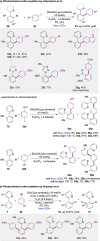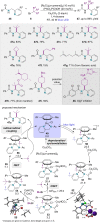Visible-Light-Induced, Single-Metal-Catalyzed, Directed C-H Functionalization: Metal-Substrate-Bound Complexes as Light-Harvesting Agents
- PMID: 35344253
- PMCID: PMC9401074
- DOI: 10.1002/anie.202201743
Visible-Light-Induced, Single-Metal-Catalyzed, Directed C-H Functionalization: Metal-Substrate-Bound Complexes as Light-Harvesting Agents
Abstract
C-H functionalization represents one of the most rapidly advancing areas in organic synthesis and is regarded as one of the key concepts to minimize the ecological and economic footprint of organic synthesis. The ubiquity and low reactivity of C-H bonds in organic molecules, however, poses several challenges, and often necessitates harsh reaction conditions to achieve this goal, although it is highly desirable to achieve C-H functionalization reactions under mild conditions. Recently, several reports uncovered a conceptually new approach towards C-H functionalization, where a single transition-metal complex can be used as both the photosensitizer and catalyst to promote C-H bond functionalization in the absence of an exogeneous photosensitizer. In this Minireview, we will provide an overview on recent achievements in C-H functionalization reactions, with an emphasis on the photochemical modulation of the reaction mechanism using such catalysts.
Keywords: Computational Chemistry; C−H Functionalization; Photocatalysis; Rhodium; Ruthenium.
© 2022 The Authors. Angewandte Chemie International Edition published by Wiley-VCH GmbH.
Conflict of interest statement
The authors declare no conflict of interest.
Figures









Similar articles
-
Weak coordination as a powerful means for developing broadly useful C-H functionalization reactions.Acc Chem Res. 2012 Jun 19;45(6):788-802. doi: 10.1021/ar200185g. Epub 2011 Dec 14. Acc Chem Res. 2012. PMID: 22166158 Free PMC article.
-
Bidentate, monoanionic auxiliary-directed functionalization of carbon-hydrogen bonds.Acc Chem Res. 2015 Apr 21;48(4):1053-64. doi: 10.1021/ar5004626. Epub 2015 Mar 10. Acc Chem Res. 2015. PMID: 25756616 Free PMC article.
-
Electronic and Steric Tuning of a Prototypical Piano Stool Complex: Rh(III) Catalysis for C-H Functionalization.Acc Chem Res. 2018 Jan 16;51(1):170-180. doi: 10.1021/acs.accounts.7b00444. Epub 2017 Dec 22. Acc Chem Res. 2018. PMID: 29272106 Free PMC article. Review.
-
Low-valent cobalt catalysis: new opportunities for C-H functionalization.Acc Chem Res. 2014 Apr 15;47(4):1208-19. doi: 10.1021/ar400270x. Epub 2014 Feb 27. Acc Chem Res. 2014. PMID: 24576170
-
Transition-Metal-Catalyzed, Coordination-Assisted Functionalization of Nonactivated C(sp3)-H Bonds.Chem Rev. 2021 Dec 22;121(24):14957-15074. doi: 10.1021/acs.chemrev.1c00519. Epub 2021 Oct 29. Chem Rev. 2021. PMID: 34714620 Free PMC article. Review.
Cited by
-
Photocatalytic regioselective C-H bond functionalizations in arenes.Chem Sci. 2024 Dec 9;16(3):1041-1070. doi: 10.1039/d4sc07491b. eCollection 2025 Jan 15. Chem Sci. 2024. PMID: 39691465 Free PMC article. Review.
-
Simplifying the Synthesis of Nonproteinogenic Amino Acids via Palladium-Catalyzed δ-Methyl C-H Olefination of Aliphatic Amines and Amino Acids.JACS Au. 2023 Jun 22;3(7):1975-1983. doi: 10.1021/jacsau.3c00215. eCollection 2023 Jul 24. JACS Au. 2023. PMID: 37502162 Free PMC article.
-
Recent Advances in Visible Light Induced Palladium Catalysis.Angew Chem Int Ed Engl. 2024 Feb 26;63(9):e202311972. doi: 10.1002/anie.202311972. Epub 2023 Nov 27. Angew Chem Int Ed Engl. 2024. PMID: 37957126 Free PMC article. Review.
-
Palladium-Catalyzed Non-Directed C─H Functionalization of Arenes with Trifluoromethylated Olefins.Chemistry. 2025 Aug 21;31(47):e01973. doi: 10.1002/chem.202501973. Epub 2025 Jul 23. Chemistry. 2025. PMID: 40702805 Free PMC article.
-
A ligand-enabled metallaphotoredox protocol for Suzuki-Miyaura cross-couplings for the synthesis of diarylmethanes.STAR Protoc. 2022 Aug 18;3(3):101618. doi: 10.1016/j.xpro.2022.101618. eCollection 2022 Sep 16. STAR Protoc. 2022. PMID: 36035803 Free PMC article.
References
Publication types
MeSH terms
Substances
LinkOut - more resources
Full Text Sources

